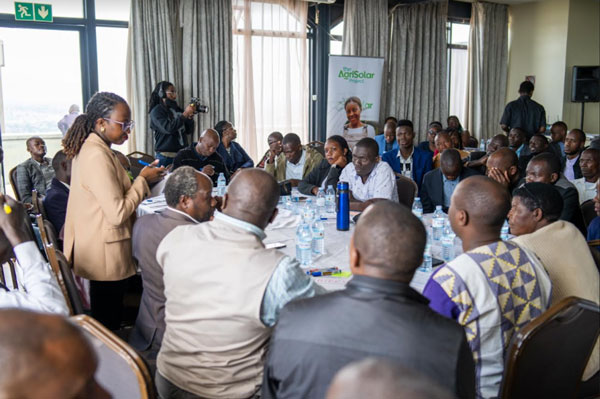
Kampala, Uganda | THE INDEPENDENT | Innovation experts have urged players in the agriculture sector to adopt and accelerate the use of solar technologies across the value chain to address the reduce the sector dependence on fossil fuels and mitigate the impact of climate change.
This was during the Agri solar Stakeholder engagement workshop organized by the Innovation Village in partnership with Youth Challenge International and Charles Stewart Mott Foundation. The workshop convened farmers, innovators, finance organization and other ecosystem actors to identify innovative models and interventions capable for driving widescale adoption and use of solar technologies in Agriculture.
Speaking at the event, Arthur Mukembo, Future Lab Studios Lead at Innovation Village said, “Uganda has a significant potential for solar energy production due to its high levels of solar radiation (4.5 – 5.5 kWh/m²/day) which the innovators can leverage on to create innovative solar solutions models to enhance production, processing, distribution and waste management processes across the agriculture value chain.”
Climate change, which at its helm is carbon emission, is the world’s biggest environmental crisis today evidenced by raging wide fires, unpredictable weather patterns, prolonged drought spells and heatwaves. The increasing carbon emissions are responsible for about two-thirds of the total energy imbalance that is causing Earth’s temperature to rise. Like a blanket or cap, these emissions trap solar heat that would have otherwise been radiated into space.
Mukembo said, “Our focus on renewable energy (particularly solar) has been because its eco-friendliness and ability to generate alternative source of energy from both thermal and electrical energy. This can then expand its ability to address a wide range of needs and challenges across various agricultural activities such as drying, cooling, running irrigation pumps, lighting, remote field monitoring, and machine operation.”
“The workshop intends to map out the challenges impeding the adoption of solar energy and develop practical solutions to unlock the massive untapped technology opportunity that can be harnessed to improve sustainability and economics of the energy mix across farming communities, improving agricultural yields and livelihoods.
While solar energy continues to be pitched as the alternative source of energy for hard-to-reach communities, the uptake of these technologies among player in the agriculture continues to be low. Morris Molole, a farmer, and representative of the Farmers Association of Uganda says this is because of the high initial costs of solar panels and batteries, limited knowledge on how to use and maintain solar equipment limited financing, technical support, and unreliable supply chain.
Therefore, there is need to increase interaction across all sector players, create platforms for knowledge sharing and networking, sector transparency, collaboration, and a better understanding that natural calamities (drought, climate change and pest infections) need to be addressed through innovation and best tech practices.
“As the Continental Free Trade Agreement opens new markets and demand for agricultural produce increases within the region, it’s crucial that we incentivize innovators to develop new equitable business models that make the consumption of solar technologies more affordable, accessible, and viable for smallholder farmers and the agricultural ecosystems to rely on to grow their crops, harvest, process and get their products to market, to ease farming and help farmers earn more.” Mukembo added.
Despite of these benefits, many barriers to widescale adoption and use exist. Hard constraints like broad availability of suitable products across various price points, distribution, ease of self-installation and others aside, the initial cost to acquire and the Total Cost of Ownership amplify the slow uptake of such solar-based solutions. “To this end, there is a need to consider the demand and supply-side opportunities to streamline the development, deployment, financing, sale, maintenance, and other aspects of consuming solar technologies for use in Agriculture, more so in the context of hard-to-reach communities”
a
 The Independent Uganda: You get the Truth we Pay the Price
The Independent Uganda: You get the Truth we Pay the Price



